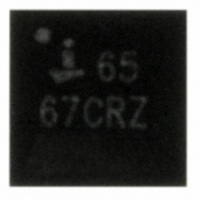ISL6567CRZ Intersil, ISL6567CRZ Datasheet - Page 13

ISL6567CRZ
Manufacturer Part Number
ISL6567CRZ
Description
IC CTLR PWM 2PHASE BUCK 24-QFN
Manufacturer
Intersil
Datasheet
1.ISL6567CRZ.pdf
(26 pages)
Specifications of ISL6567CRZ
Pwm Type
Voltage Mode
Number Of Outputs
1
Frequency - Max
1.5MHz
Duty Cycle
66%
Voltage - Supply
4.9 V ~ 5.5 V
Buck
Yes
Boost
No
Flyback
No
Inverting
No
Doubler
No
Divider
No
Cuk
No
Isolated
No
Operating Temperature
0°C ~ 70°C
Package / Case
24-VQFN
Frequency-max
1.5MHz
Rohs Compliant
YES
Lead Free Status / RoHS Status
Lead free / RoHS Compliant
Available stocks
Company
Part Number
Manufacturer
Quantity
Price
Company:
Part Number:
ISL6567CRZ
Manufacturer:
Intersil
Quantity:
620
Company:
Part Number:
ISL6567CRZ
Manufacturer:
INTERSIL
Quantity:
8 831
Part Number:
ISL6567CRZ
Manufacturer:
INTERSIL
Quantity:
20 000
Part Number:
ISL6567CRZ-T
Manufacturer:
INTERSIL
Quantity:
20 000
SETTING THE OUTPUT VOLTAGE
The ISL6567 uses a precision internal reference voltage to
set the output voltage. Based on this internal reference, the
output voltage can thus be set from 0.6V up to a level
determined by the input voltage, the maximum duty cycle,
and the conversion efficiency of the circuit; Equation 7
estimates this maximum amplitude the output voltage can be
regulated to. Obviously, insure that the input voltage and all
the voltages sampled by the ISL6567 do not exceed the
controller’s absolute maximum limits, or any other limits
specified in this document.
The output voltage can be set via a simple resistor divider,
as shown in Figure 8. It is recommended this resistor divider
is connected at the input of the differential amplifier (as this
amplifier is powered from the IC’s 5V bias and has limited
input range). To avoid degradation of DC regulation
tolerance due to the differential amplifier’s input resistance, a
size requirement is placed on the combined value of R
R
resistors, and use a value of 2kΩ or less for R; use the
following equations to determine the value of R
based on the desired output voltage, the reference voltage,
and the chosen value of R.
V
R
S
OUTMAX
P
FIGURE 8. SETTING THE OUTPUT VOLTAGE AT THE INPUT
. Consider R to be the parallel combination of these two
=
R
DIFFERENTIAL
AMPLIFIER
AMPLIFIER
⋅
ERROR
------------------------------------ -
V
V
=
OUT
REF
d
V
OF THE DIFFERENTIAL AMPLIFIER
MAX
OUT
–
V
X1
REF
+
-
⋅
ISL6567
V
+
IN
-
⋅
Efficiency
13
VDIFF
RGND
FB
EXTERNAL CIRCUIT
VSEN
R
S
=
R
R
1
⋅
R
V
--------------- -
V
P
OUT
REF
R
S
P
and R
To V
+
-
(EQ. 7)
(EQ. 8)
P
S
OUT
and
,
ISL6567
ISL6567
The differential amplifier can be used even if remote output
sensing is not desired or not feasible, simply connect RGND
to the local ground and connect VSEN to the output voltage
being monitored. Should one desire to bypass the differential
amplifier, the circuit in Figure 9 is recommended as the
proper implementation. Since its output is monitored for OVP
and PGOOD purposes, the differential amplifier needs to be
connected to the feedback circuit at all times, hence its input
connections to FB and local ground. However, its output,
VDIFF, can be left open. The resistor divider setting the
output voltage is calculated in a manner identical to that
already revealed.
FIGURE 10. SETTING THE OUTPUT VOLTAGE AT THE INPUT
FIGURE 9. SETTING THE OUTPUT VOLTAGE AT THE FB PIN
DIFFERENTIAL
Z
OVER PROCESS, TEMPERATURE, AND
0 < VSEN-RGND < 2.5V
IN
AMPLIFIER
DIFFERENTIAL
AMPLIFIER
> 240kΩ
AMPLIFIER
ERROR
V
REF
OF THE DIFFERENTIAL AMPLIFIER
+
X1
-
+
-
ISL6567
+
-
VDIFF
RGND
FB
VSEN
EXTERNAL CIRCUIT
Z
IN
ISL6567
~2µA
R
P
R
S
VSEN
RGND
VDIFF
EXTERNAL
(R
CIRCUIT
1
)
To V
May 28, 2009
FN9243.3
OUT
+












